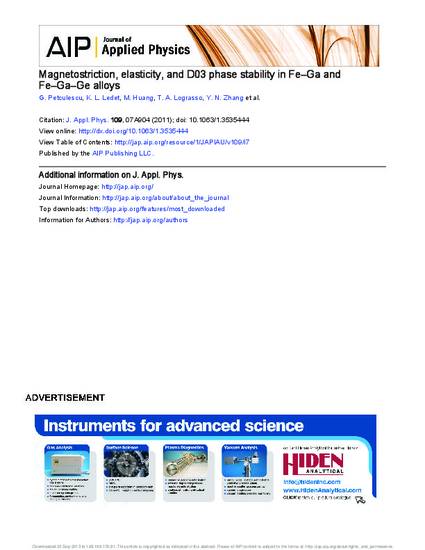
Presentation
Magnetostriction, elasticity, and D03 phase stability in Fe–Ga and Fe–Ga–Ge alloys
Ames Laboratory Conference Papers, Posters, and Presentations
Document Type
Conference Proceeding
Disciplines
Conference
55th Annual Conference on Magnetism and Magnetic Materials
Publication Date
3-18-2011
Geolocation
(33.7489954, -84.3879824)
Abstract
The contrast between the saturation tetragonal magnetostriction, λγ,2 = (3/2)λ100, of Fe1−xGax and Fe1−yGey, at compositions where both alloys exhibit D03 cubic symmetry (second peak region), was investigated. This region corresponds to x = 28 at. % Ga and y = 18 at. % Ge or, in terms of e/a = 2 x + 3 y + 1, to an e/a value of ∼1.55 for each of the alloys. Single crystal, slow-cooled, ternary Fe1−x−y GaxGey alloys with e/a ∼1.55 and gradually increasing y/x were investigated experimentally (magnetostriction, elasticity, powder XRD) and theoretically (density functional calculations). It was found that a small amount of Ge (y = 1.3) replacing Ga in the Fe–Ga alloy has a profound effect on the measured λγ,2. As y increases, the drop in λγ,2 is considerable, reaching negative values at y/x = 0.47. The two shear elastic constants c′ = (c11− c12)/2 and c44 measured for four compositions with 0.06 ≤ y/x ≤ 0.45 at 7 K range from 16 to 21 GPa and from 133 to 138 GPa, respectively. Large temperature dependence was observed for c′ but not for c44, a trend seen in other high-solute Fe alloys. The XRD analysis shows that the metastable D03 structure, observed previously in slow-cooled Fe–Ga at e/a = 1.55, is replaced with two phases, fcc L12 and hexagonal D019, at just 1.6 at. % Ge. The two are the stablephases of the assessed Fe–Ga phase diagram at x ∼ 28. Notably, at y = 7.8, only the D03phase (the equilibrium phase of Fe–Ge at e/a = 1.54) was found in the ternary alloy. The theory also shows that the D03 instability is removed for compositions with y ≥ 3.9, when D03 becomes the structure’s ground-state phase. Thus, the high, positive λγ,2 value for Fe–Ga at x = 28 could be the result of the high sensitivity of its metastable D03 structure.
Copyright Owner
American Institute of Physics
Copyright Date
2011
Language
en
Citation Information
G. Petculescu, K. L. Ledet, Mianliang Huang, Thomas A. Lograsso, et al.. "Magnetostriction, elasticity, and D03 phase stability in Fe–Ga and Fe–Ga–Ge alloys" Atlanta, GA(2011) Available at: http://works.bepress.com/thomas_lograsso/100/

Copyright 2011 American Institute of Physics. This article may be downloaded for personal use only. Any other use requires prior permission of the author and the American Institute of Physics.
The following article is from Journal of Applied Physics 109 (2011): 07A904 and may be found at http://dx.doi.org/10.1063/1.3535444.